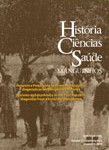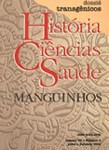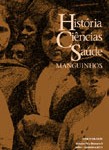Mayo 2019

Ana Barahona is full Professor at the Department of Evolutionary Biology, Universidad Nacional Autónoma de Mexico (UNAM). She studied biology and performed postgraduate studies on the history of science at the UNAM, stayed at Harvard University for a year, undertook postdoctoral studies at the University of California, and has made several research visits to the Max Planck Institute in Berlin.
Our latest dossier on the transnational knowledge during the Cold War (vol. 26 no.1 Jan./Mar. 2019) shows that this period affected not only science and technology related to the military and space races, but also research in biomedicine and other fields.
In this brief interview to our blog, Ana Barahona, editor of the dossier, explains the main characteristics of science during the Cold War era, the relevance of a transnational perspective and the relation between scientific knowledge in Latin America and the polarized political order.
She also talks about her article on genetics of populations in Mexico, published in this dossier.
Broadly speaking, which are the main characteristics of science during the Cold War era in a transnational perspective?
Science during the Cold War, as Zuoyue Wang has argued,[1] has become a hotspot in the history of science. Science during the Cold War became an international phenomenon due, in part, to the remarkable expansion of state-funded medical science and military patronage of scientific work in the life sciences that occurred during the Cold War in industrialized and developing countries. The transnational perspective illustrates the often hidden transnational movements of people, instruments, and ideas in science and technology across borders, and highlights the limitations of the national histories that have dominated the history of science in the last decades of the 20th century.
Instead, the transnational perspective broadens the studies of post-1945 science into, as is the case in the dossier, Europe and Latin America (Spain, Mexico and Brasil), and brings to the fore the intricate relationships of global science with local contexts and between science and socio-political factors.
 How can we relate the circulation of this scientific knowledge, especially in Latin America, to the polarized political order of the Cold War?
How can we relate the circulation of this scientific knowledge, especially in Latin America, to the polarized political order of the Cold War?
Authors like John Krige have acknowledge the co-production of knowledge in the process of the “Americanization” of science in the Cold War period. [2] Krige has shown how American scientists were influential on the reconstruction of European science, while at the same time realized that working closer to scientific local elites they were propelling science globally.
In the case of recent historical studies of science in Latin America, Asia and Africa, a lot of research performed under the transnational approach has account for how the knowledge produced in developing countries forms part of international knowledge as it circulates in international networks of collaboration.
This perspective has enabled the production of narratives that go beyond the national framework through analysis of transnational participants and processes, and has permitted new ways of thinking about science history in national and regional contexts.[3]
Which are the main contributions of this period to the History of Science?
It is fair to say that among the main contributions of this period to the History of Science are the recognition of science as an international enterprise, the collaborative networks that were established after WWII, especially biomedicine that became the dominant medical system globally, the global concerns about the effects of nuclear radiation on human and populations at the intersection of nuclear physics and genetics after the atomic bombs, and the need to deliver healthcare services and scientific knowledge to the general population. Also, the abandonment of the center-periphery perspective with its reception studies and the diffusionist model.[4]
In the dossier “Transnational knowledge during the Cold War” you wrote an article on genetics of populations in Mexico. Can you talk a little bit about the results of your study?
I began studying he history of population genetics in Mexico almost two decades ago. I was interested at the time in the process of institutionalization of genetics in the country: what institutions were built, in which journals were published the results of the Mexican researchers, who were the main researchers and with whom did they study abroad, etc.
In more recent times, I´m interested in the transnational perspective in the history of science that pays attention to the flow of people, instruments, and practices, across borders. In the paper appeared in Manguiños I explored the connection between two colleagues and friends, cytogeneticist Salvador Armendares and population geneticist Rubén Lisker in their personal agendas and academic practices during Cold War Mexico, to see if their work fit the post-1945 human genetics endeavor in a global context, and also explored how the populations they studied, child and indigenous, were considered laboratories of knowledge production.
I tried to show how Armendares and Lisker were key elements in the constructions of national scientific policies in the clinic to improve the healthcare system and tackle national priorities such as Down syndrome, child malnutritions or lactase deficiencies. They both connected their field sites with the clinic at a moment when biomedicine was emerging as a post-World War II enterprise. In this way I tried to show their contributions to global knowledge on human biology by demonstrating how the practices of cytogenetics and population genetics were combined intellectually and institutionally.
[1] Wang, Zouyue. 2010. Transnational Science during the Cold War. Isis 101:367-377.
[2] Krige, John. 2006. American Hegemony and the Postwar Reconstruction of Science in Europe. Cambridge, Mass.: MIT Press.
[3] Barahona, Ana. 2019. Local, Global and Transnational Perspectives on the History of Biology. En: Dietrich, M., Borrello, M., & Harman, O. (Eds.). Handbook of the Historiography of Biology. Historiography of Science, vol. 1. Cham: Springer. pp. 229-250.
[4] Basalla, G. The Spread of Western Science. A three-stage model describes the introduction of modern science into any non-European nation. Science 1967; 156: 611-622.
Read in Manguinhos:
Barahona, Ana. Karyotyping and population genetics in Cold War Mexico: Armendares’s and Lisker’s characterization of child and indigenous populations, 1960s-1980s. Hist. cienc. saude-Manguinhos, vol.26, no.1, Jan./Mar. 2019.
Barahona, Ana. Transnational knowledge during the cold war: the cse of the life and medical sciences. Hist. cienc. saude-Manguinhos, Hist. cienc. saude-Manguinhos, vol.26, no.1, Jan./Mar. 2019.
Torrens, Erica. Biomedical knowledge in Mexico during the Cold War and its impact in pictorial representations of Homo sapiens and racial hierarchies, Hist. cienc. saude-Manguinhos, vol.26, no.1, Jan./Mar. 2019.
Pablos, Ana Romero de. Knowledge that traveled between Italy and Spain during the Franco regime: the construction of radioactivity counters, Hist. cienc. saude-Manguinhos, vol.26, no.1, Jan./Mar. 2019.
Carvalho, Tito. “A most bountiful source of inspiration:” Dobzhansky’s evolution of tropical populations, and the science and politics of genetic variation, Hist. cienc. saude-Manguinhos, vol.26, no.1, Jan./Mar. 2019.








